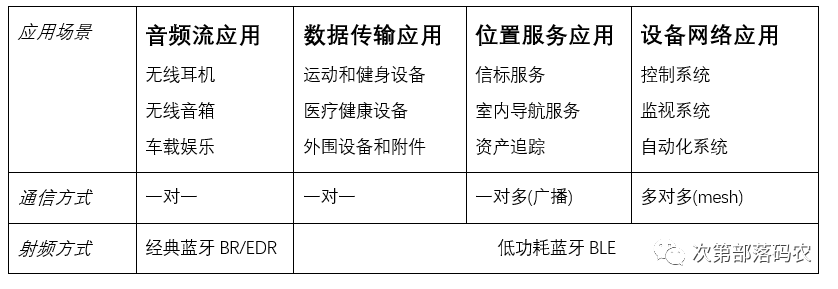What are the differences between classic Bluetooth and Bluetooth low energy (BLE or LE)? Why are they both called “Bluetooth”? What is the difference between Bluetooth low energy and Bluetooth smart? Which technology should I choose for my application, classic Bluetooth or low energy Bluetooth? These are common questions for those who are new to Bluetooth technology.
First of all, before 2010, when we talked about Bluetooth, we were referring to classic Bluetooth, as low energy Bluetooth did not exist at that time. Classic Bluetooth was proposed and maintained by the Bluetooth Special Interest Group (Bluetooth SIG). Each time the SIG releases a new version of the Bluetooth specification, it specifies the version number, such as Bluetooth specification 1.0/2.0, etc. Bluetooth 1.0 was released around 1999, Bluetooth 2.0 in 2004, Bluetooth 2.1 in 2007, and Bluetooth 3.0 in 2009; all of these were released before 2010. Therefore, Bluetooth 1.0/2.0/2.1/3.0 all refer to classic Bluetooth, and there is no mention of low energy Bluetooth in them. If you open the Bluetooth 3.0 specification document, you will find that classic Bluetooth includes three modes: BR, EDR, and HS (AMP).
In simple terms, any technology released by the Bluetooth Special Interest Group (SIG) can be referred to as Bluetooth technology. In 2010, the SIG merged with the Wibree Alliance (note: the Wibree Alliance was founded by Nokia and Nordic, aiming to find a lower power wireless communication technology for mobile peripheral devices), and renamed the low-power wireless technology proposed by the Wibree Alliance as Bluetooth low energy technology (BLE). Since then, BLE has also become a type of Bluetooth technology. Accordingly, the Bluetooth 4.0 specification released in 2010 includes both classic Bluetooth and low energy Bluetooth. This means that from Bluetooth 4.0 onwards, Bluetooth is divided into classic Bluetooth and low energy Bluetooth. In fact, the term “classic Bluetooth” is not very professional; it was created by the public for convenience. In the Bluetooth 4.0 specification, the SIG defined four types of Bluetooth controller technologies: BR, EDR, AMP, and LE. This means that there is only one type of Bluetooth, which is the Bluetooth from SIG, and Bluetooth technology itself includes four types: BR, EDR, AMP, and LE. Since LE was proposed in 2010, which is relatively new, it is more convenient to refer to the earlier BR/EDR/AMP technologies as classic Bluetooth technology. It is important to note that after Bluetooth 4.0, Bluetooth does not only have LE mode!
To distinguish between low energy Bluetooth and classic Bluetooth, at the beginning of the release of Bluetooth 4.0, the SIG specifically promoted Bluetooth low energy as Bluetooth smart, while “Bluetooth” continued to refer to classic Bluetooth. Bluetooth smart ready was used to indicate dual-mode Bluetooth (i.e., supporting both classic Bluetooth and low energy Bluetooth). Therefore, there are many promotional materials about Bluetooth smart, Bluetooth, and Bluetooth smart ready on the market. However, these names not only failed to promote the Bluetooth brand but also confused many consumers and developers. Consequently, the SIG stopped frequently using names like Bluetooth smart and aligned more with the Bluetooth 4.0 specification, directly using names like LE, BR, and EDR for promotion, and no longer promoted the differences between low energy Bluetooth and classic Bluetooth, instead unifying both under the larger brand of “Bluetooth”.
The Bluetooth Special Interest Group (SIG) subsequently released Bluetooth 4.1/4.2/5.0, which also includes both low energy Bluetooth and classic Bluetooth. Therefore, when developing Bluetooth applications, it is crucial to understand whether you are developing a low energy Bluetooth application or a classic Bluetooth application, as their application scenarios are different. Generally speaking, classic Bluetooth is mainly used in scenarios like Bluetooth phone calls, Bluetooth headsets, and Bluetooth speakers, while low energy Bluetooth is used in wearable devices, IoT smart devices, fitness devices, and Bluetooth mice and keyboards, typically in battery-powered scenarios. Of course, classic Bluetooth can also be battery-powered, but LE has lower battery requirements and can even be powered by button batteries, with a long battery life; some LE devices can last for years. The following image summarizes the typical application scenarios of classic Bluetooth and low energy Bluetooth.

It is important to note that the physical layer modulation methods of classic Bluetooth and low energy Bluetooth are different, so low energy Bluetooth devices and classic Bluetooth devices cannot communicate with each other. When selecting, do not confuse them. If the master device is a low energy Bluetooth device, the slave device must also be a low energy Bluetooth device; similarly, classic Bluetooth slave devices can only communicate with classic Bluetooth master devices. However, there is also a type of dual-mode Bluetooth device on the market, which supports both low energy Bluetooth and classic Bluetooth. For example, the smartphones we use every day can communicate with classic Bluetooth devices as well as low energy Bluetooth devices. As mentioned earlier, this does not mean that low energy Bluetooth devices can communicate with classic Bluetooth devices; in fact, smartphones use a time-sharing mechanism to achieve simultaneous communication with both low energy Bluetooth devices and classic Bluetooth devices. This means that smartphones allow the dual-mode Bluetooth chip to continuously switch between low energy Bluetooth mode and classic Bluetooth mode to support both types of devices simultaneously. When selecting low energy Bluetooth solutions, classic Bluetooth solutions, or dual-mode Bluetooth solutions, it is essential to understand the differences between them to choose the Bluetooth solution that best suits your needs.